#rpa testing
Explore tagged Tumblr posts
Text
Test Management Tools Compared: Features, Pricing, and Use Cases
Choosing the right test management tool can make or break your QA process.
We’ll break down essential features such as test case creation, requirement traceability, integration with CI/CD pipelines, real-time reporting, and collaboration support. Some test management tools excel in Agile environments, while others are better suited for traditional test cycles or large enterprises.
Next, we explore pricing models—from subscription-based to one-time licenses and open-source alternatives—highlighting what small teams vs. enterprises should consider.
Finally, we include use case examples from different industries (finance, healthcare, SaaS) to show how these tools fit into unique QA workflows. Whether you're looking for a lightweight solution or an enterprise-grade platform, this comparison will help you make a confident choice.
#qa services#qa software#qa testing services#qa testing software#automated software testing#software testing#automated system testing#robotic automation solution#rpa testing#test automation#test management tools
0 notes
Text
Trends and Forecasts for Test Automation in 2025 and Beyond

Overview
The demand for advanced test automation is rising due to the rapid advancements in AI-driven futures, ML, and software. The scope of test automation is expanding from basic functionality tests to complex domains like security, data integrity, and user experience. The future of Quality Engineering will see new standards for efficiency, accuracy, and resilience.
AI-Powered Testing Will Set the Standard
By 2025, AI-driven testing will dominate test automation, with machine learning enabling early detection of shortcomings. AI-powered pattern recognition will enhance regression testing speed and reliability. By 2025, over 75% of test automation frameworks will have AI-based self-healing capabilities, creating a more robust and responsive testing ecosystem.
No-Code and Low-Code Testing Platforms' Ascent
The rapid development is prompting the rise of no-code and low-code test automation solutions. These platforms allow technical and non-technical users to write and perform tests without advanced programming skills. By 2026, they are predicted to be used in 80% of test automation procedures, promoting wider adoption across teams.
Testing that is Autonomous and Highly Automated
Hyper-automation, a combination of AI, machine learning, and robotic process automation, is revolutionizing commercial processes, particularly testing. By 2027, enterprises can automate up to 85% of their testing operations, enabling continuous testing and faster delivery times, reinforcing DevOps and agile methodologies.
Automated Testing for Privacy and Cybersecurity
Test automation is advancing in ensuring apps comply with global security standards and regulations, including GDPR, HIPAA, and CCPA. By 2025, security-focused test automation is expected to grow by 70%, becoming crucial in businesses requiring privacy and data integrity. This technology will enable real-time monitoring, threat detection, and mitigation in the face of increasing cyberattacks.
Testing Early in the Development Cycle
Shift-left testing is a popular method for detecting and addressing flaws in the early stages of development, reducing rework, and improving software quality. It is expected to increase as tests are integrated with advanced automation technologies. By 2025, DevOps-focused firms will use shift-left testing, reducing defect rates by up to 60% and shortening time-to-market.
Testing's Extension to Edge Computing and IoT
The increasing prevalence of IoT devices and edge computing will significantly complicate testing, necessitating numerous setup changes and real-time data handling due to network and device differences. By 2026, IoT and edge computing test automation will account for 45% of the testing landscape, with increasing demand in healthcare, manufacturing, and logistics.
The Need for Instantaneous Test Analytics and Reports
Real-time analytics are crucial in test automation, enabling data-driven decisions and improved test coverage, defect rates, and quality. By 2025, 65% of QA teams will use real-time analytics to monitor and optimize test automation tactics, resulting in a 30% increase in testing productivity.
Testing Across Platforms for Applications with Multiple Experiences
Multi-experience applications, which work across multiple platforms, require extensive testing for compatibility, responsiveness, and UX. By 2025, 80% of businesses will have implemented cross-platform test automation technologies, enhancing multi-experience application quality by 45%. AI-based tools will replicate human interaction across multiple platforms.
Using Containerization and Virtualization to Simulate Environments
Test automation relies heavily on virtualization and containerization, with Docker and Kubernetes technologies enabling virtualized environments that resemble production. By 2025, containerized testing environments will enable 65% of test automation, allowing quicker and more flexible testing solutions, reducing dependencies, and increasing testing scalability and accuracy.
The Expanding Function of AI-Powered RPA in Test Automation
RPA integrates with AI to create sophisticated automation solutions, increasing productivity in repetitive testing operations, data transfer, and system integrations. By 2026, AI-enhanced RPA will account for 45% of test automation in industries with highly repetitive testing, such as banking, healthcare, and manufacturing, enabling complex judgments and dependable outcomes.
An increasing emphasis on accessibility testing
Due to increased accessibility priorities, the demand for accessibility testing in businesses has surged. Automated tools will detect issues like color contrast, screen reader compatibility, and keyboard navigation assistance, ensuring WCAG compliance. By 2025, over 65% of enterprises aim for inclusive and accessible user experiences.
Accepting the Future of Automated Testing
The next generation of test automation, utilizing AI, machine learning, and RPA, holds immense potential for creating high-quality, secure, and user-friendly apps. Sun Technologies, a leading testing solutions provider, must stay ahead of these trends to provide clients with the most modern testing solutions available.
Are you set to transform your test automation journey?
Contact us at suntechnologies.com to learn more about how we can help you grasp the newest testing trends and technology.
Together, let's define the future of quality engineering!
0 notes
Text
Unveiling the Importance of RPA Testing
Thorough testing becomes essential when companies employ Robotic Process Automation (RPA) to automate tasks and enhance efficiency. Ensuring that automated processes operate seamlessly and deliver the intended outcomes underscores the importance of RPA testing.
Understanding RPA Testing
RPA testing Sydney is super important in the process automation journey. It’s all about checking if the automated tasks work well in meeting its objective. Unlike regular software tests, RPA testing faces its own set of challenges because automated work is always changing and involves different types of applications and integrations.
Know more: Unveiling the Importance of RPA Testing (adactin.com)
#rpa testing services sydney#rpa testing sydney#robotic process automation sydney#software testing services sydney
0 notes
Text
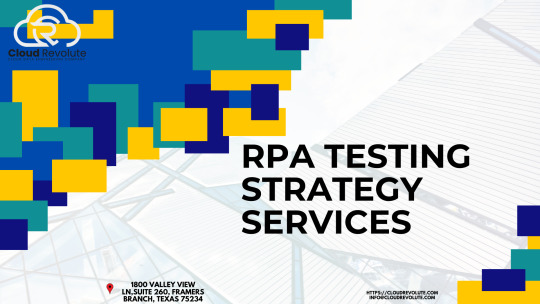
Robotic Process Automation Testing Framework-Cloud Revolute
0 notes
Text
Unlocking Your Potential: TechMindz Infopark Kochi - The Premier Software Training Institute
Are you ready to embark on a transformative journey in the world of IT? Look no further than TechMindz Infopark Kochi, the leading software training institute that is revolutionizing the way individuals learn and excel in the field of technology.
Introduction: In today's fast-paced digital landscape, the demand for skilled IT professionals is higher than ever before. With technology evolving at lightning speed, it's crucial for aspiring professionals to receive top-notch training from reputable institutions. Enter TechMindz Infopark Kochi – a name synonymous with excellence, innovation, and success in the realm of software training.
Why Choose TechMindz Infopark Kochi?
Cutting-Edge Curriculum: At TechMindz Infopark Kochi, we pride ourselves on offering a cutting-edge curriculum that is meticulously crafted to meet the demands of the ever-evolving IT industry. From foundational concepts to advanced technologies, our courses cover a wide spectrum of topics designed to equip students with the skills and knowledge needed to thrive in today's competitive job market.
Expert Faculty: Our team of experienced faculty members comprises industry veterans, renowned experts, and seasoned professionals who bring a wealth of knowledge and expertise to the classroom. With years of hands-on experience in their respective fields, our instructors are committed to providing personalized guidance, mentorship, and support to help students reach their full potential.
Hands-On Learning: At TechMindz Infopark Kochi, we believe in the power of hands-on learning. That's why our courses are designed to offer practical, real-world experience through hands-on projects, case studies, and interactive workshops. By immersing themselves in hands-on activities, students gain valuable insights, sharpen their skills, and build the confidence needed to tackle complex challenges head-on.
State-of-the-Art Facilities: Our state-of-the-art facilities provide students with an immersive and conducive learning environment where they can thrive and excel. From modern classrooms equipped with the latest technology to dedicated lab spaces for hands-on practice, we spare no effort in ensuring that students have access to the resources they need to succeed.
Career Support: At TechMindz Infopark Kochi, our commitment to our students goes beyond the classroom. We offer comprehensive career support services, including resume building, interview preparation, and job placement assistance, to help students transition seamlessly from the classroom to the workforce. Our extensive network of industry connections and partnerships ensures that students have access to a wide range of job opportunities upon graduation.
Conclusion: In conclusion, TechMindz Infopark Kochi is more than just a software training institute – it's a gateway to a world of endless possibilities and opportunities in the field of IT. With our cutting-edge curriculum, expert faculty, hands-on learning approach, state-of-the-art facilities, and unwavering commitment to student success, we are dedicated to empowering the next generation of IT professionals to achieve their dreams and make a meaningful impact in the world of technology.
https://www.techmindz.com/courses/
#techmindzkochi#infopark#softwaretraining#python#datascience#digitalmarketing#software testing#ui/ux#corporatetraining#RPA#java#flutter#placement#joborientedcourse#kerala#IT#onlinecourses#onlinetraining#liveclass
0 notes
Video
youtube
Battle of the Bots: Test Automation vs. RPA Tools - Which Automation Champion Wins
In this intriguing video, we dive into the world of automation to explore the key differences and similarities between RPA (Robotic Process Automation) and Test Automation. 💡
Are you curious about which automation solution is the right fit for your needs? We've got you covered! Join us as we break down the roles, focuses, and applications of RPA and Test Automation. 🤖🧪
Discover how RPA streamlines business processes and makes your work easier, while Test Automation tools ensure the correctness of your software. 🚀
With insights, examples, and a touch of humor, we'll help you make an informed choice between these two automation powerhouses.
Don't miss out on this informative discussion! Hit that play button and let's navigate the world of RPA vs. Test Automation together. 🎬🔍
0 notes
Text
what is Embedded Software Testing?
Embedded software testing refers to the process of evaluating and validating the software running on embedded systems. Embedded systems are specialized computer systems designed to perform specific functions within larger devices or machinery. They are typically found in various applications such as automobiles, medical devices, consumer electronics, industrial equipment, and more.
Embedded software testing involves assessing the functionality, reliability, performance, and safety of the software that operates these embedded systems. The testing process aims to identify defects, errors, and vulnerabilities within the software, ensuring that it meets the desired specifications and requirements.
Some common types of testing techniques used in embedded software testing include:
Unit Testing: Testing individual components or modules of the software to ensure they function correctly.
Integration Testing: Verifying the proper interaction and communication between different software modules within the embedded system.
System Testing: Evaluating the overall functionality and behavior of the entire embedded system, including the software and hardware components.
Performance Testing: Assessing the performance and responsiveness of the embedded software under different conditions and loads.
Security Testing: Identifying vulnerabilities and weaknesses in the software to protect against potential security threats and breaches.
Regression Testing: Repeatedly testing the software to ensure that recent changes or updates have not introduced new defects or caused any regressions.
Usability Testing: Evaluating the user-friendliness and ease of use of the embedded software interface.
Safety Testing: Assessing the software's compliance with safety standards and ensuring it operates reliably to prevent any potential harm or accidents.
Embedded software testing requires specialized knowledge and expertise due to the unique challenges posed by the embedded systems' hardware limitations, real-time constraints, and specific application requirements. Testers often use a combination of manual testing techniques and automated testing tools to thoroughly assess the embedded software's quality and functionality.
For More, You Can Visit This Post: Embedded Software Testing: Ensuring Quality and Reliability
Robonito Is a no-code automation testing tool for software and web apps that can automate your software testing
#software testing#testing#web application#no code automation testing tool#software testing tool#robonito#RPA
0 notes
Text
Our Life Modding Guide
For anyone wanting to know how to either look into the game files themselves or write in their own scenes, here it is!
(Real quick, here's a link to GB Patch's opinion on modding - which is that we're free to do so - just in case anyone may be concerned about that; here's another as well.)
Preparation
I'm going to say right up front that I have the itch.io Windows version of Our Life, so your methods may vary on anything else. The Steam version is the exact same to my knowledge, however, so this should work exactly the same for it (I've had people who use the Steam version test mine for me).
While this may go without saying, definitely back up your game before anything else, both as a precaution and also to keep the original around (whether for comparison's sake, you might want to still play the original, or in case something goes wrong and you need to reinsert any of the original files). I usually keep the modded version's folder somewhere away from the original, but that's just me. You can also just make sure to mark it.

Unpacking Our Life's Files
One peek into the "game" folder of Our Life will reveal... well, not much. Some icon files, a couple images, two folders for your save files and cache, and little else. This is because everything else is packed into the .rpa files and we need to open them up. Think of it like a safe that we need to unlock, or luggage that we need to unzip.
Depending on how many DLCs you have (the only one I don't have is Voiced Names, which would be dlc_voiced_names.rpa), the amount of .rpa files will be any/all of these:

There are a few different ways to unpack these and I'll be listing multiple on the off chance that the others don't work (ordered by ease of use/overall usefulness).
RPA Extract (by iwanplays)
This is the easiest method out of all and the first I recommend you try. You can find it here.
It's a single .exe file and all you have to do is drop it into the "game" folder of Our Life, select all of the .rpa files, and drag them onto the .exe.
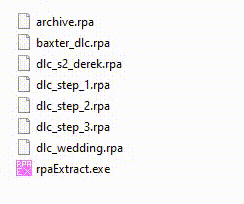
This will open a Command Prompt that will extract all of the files for you, and you can delete the rpaExtract.exe after it's done. Simple as that.
RPA Explorer (by UniverseDevel)
This one is useful if you only want to look at the files and not extract/edit them, though it can do that too. You can find it here. The disadvantage from RPA Extract is that you'll have to extract the .rpa files one at a time instead of all at once.
After downloading, open the program and click on "Load File" in the upper-left.

Locate your .rpa files and open one. You'll see folders and files pop up, showing you all the files inside of the .rpa file you chose. You're free to look at any of them as you please, but if you want to extract them, check the box next to the "/" folder to select everything and then click "Export checked" in the upper-left.
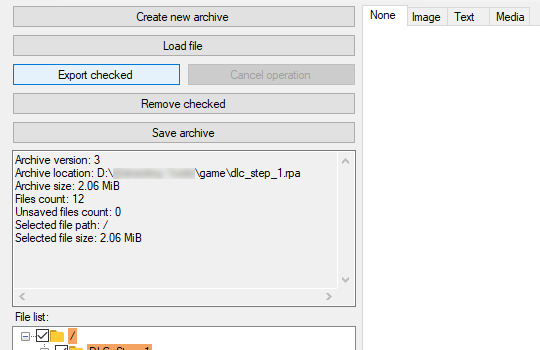
Locate the "game" folder in the Our Life folder that you want to mod, click on it, then click "OK".

A progress bar will appear in the lower-right and the files will be extracted. Repeat this process for the remaining .rpa files.
rpaextract (by Kaskadee)
This method is a little more complicated and therefore requires some more steps. You can find it here (you can simply download the portable version).
Rather than in the case of RPA Extract, you'll want to take the .rpa files out of Our Life's game folder and put them in the folder of whichever you downloaded. This will just make it easier in the long run.
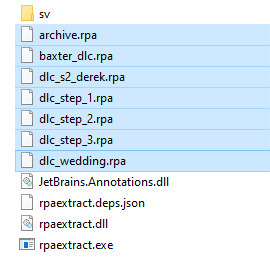
Once everything is moved, right-click on the address above for the folder, click "Edit Address," and type "cmd" at the beginning before tapping Enter.


A Command Prompt will open with the name of the folder. You'll have to extract your .rpa files one at a time here.
You'll then type out (without the brackets):
rpaextract -x -f [filename].rpa -o game

The .rpa files will be extracted (as shown above, it will give you a loading bar to show progress then pop up the address for you to type something out again when it's done) and appear in a folder titled "game." You can then copy that folder and paste it over Our Life's game folder, combining the contents of both together.
Testing
Now that you have your files extracted, you can delete the .rpa files that you had extracted from because we don't need them anymore. The "game" folder of Our Life should look something like this:

You should also still be able to open the .exe of Our Life and load to the main menu without experiencing any error messages. Tapping on "DLC Info" in the upper-left of the main menu should also still have all the DLCs you had listed as "Installed."

If all that checks out, you're good to continue!
Setting Up Your Text Editor
You'll need a text editor for this and, for size's sake, I'm going to recommend Notepad++, which you can find here. You can just download the portable version but it doesn't really matter.
Once it's been opened, we're going to do a few steps to make it recognize Our Life's script (.rpy) files (the ones you'll be tampering with if you want to add scenes/change dialog/etc.).
Go into the "Settings" tab at the top, then click "Style Configurator".

2. Scroll through the "Language" section until you find "Python". Click on that.
3. Under "User ext. :" at the bottom, type "rpy" without quotations.
4. Hit "Save & Close".

5. Go to "Settings" again, then click "Preferences".

6. Find "Language" on the left of the window that pops up and click on that.
7. Look for "Tab Settings" on the right. It should be set to "Default", the "Tab size" should be "4", and you should checkmark the "Replace by space" box. You can then hit "Close".
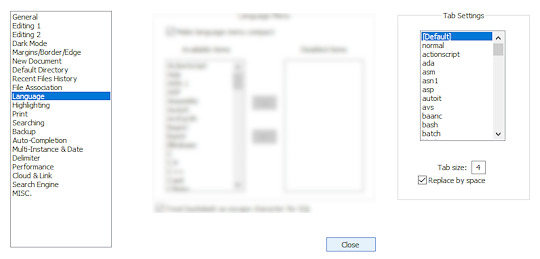
(an important part of the code is indenting and this just streamlines it so that when you push "Tab" it will insert four spaces instead)
8. Go back to the Our Life "game" folder, then find an .rpy file (any will do), right-click it, then hit "Open with…"

9. Check the "Always use this app to open .rpy files" box.
10. Click on "Notepad++". If it's not there right away, hit "More apps", and if it's still not there then scroll all the way down and hit "Look for another app on this PC" and find+confirm the Notepad++.exe.
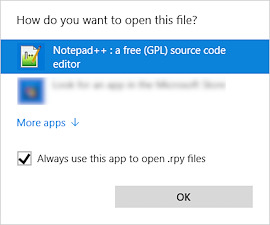
Now Notepad++ will automatically open any .rpy file that you double-click on and will treat them appropriately.
And now you're ready to go! The .rpy files are actually Our Life's script files, which can be freely opened in Notepad++ (or another text editor) to edit the game's scenes or add your own.
Happy modding!
29 notes
·
View notes
Text

The D-21 Drone and project Senior Bowl: i.e. the SR-71 Blackbird was not the Most Secret Program ever developed by famed Lockheed Skunk Works
The D-21 Drone and project Senior Bowl
At Beale Air Force Base (AFB), in California, you would think that the SR-71 Blackbird program would be the biggest blackest deepest secret.
But you would be wrong.
The biggest secret was Project Tagboard/Senior Bowl.

CLICK HERE to see The Aviation Geek Club contributor Linda Sheffield’s T-shirt designs! Linda has a personal relationship with the SR-71 because her father Butch Sheffield flew the Blackbird from test flight in 1965 until 1973. Butch’s Granddaughter’s Lisa Burroughs and Susan Miller are graphic designers. They designed most of the merchandise that is for sale on Threadless. A percentage of the profits go to Flight Test Museum at Edwards Air Force Base. This nonprofit charity is personal to the Sheffield family because they are raising money to house SR-71, #955. This was the first Blackbird that Butch Sheffield flew on Oct. 4, 1965.
Project Tagboard/Senior Bowl is a relatively unknown project in the history of Area 51 reconnaissance A-12 aircraft. This project was Top Secret from its inception and during the Senior Bowl part of the project, there were less than 100 personnel cleared to work on it.
According to Air Force Test Center History Office documents, all manned flights over the Soviet Union were discontinued by President Dwight Eisenhower after Francis Gary Powers’ U-2 spy plane was shot down May 1, 1960. However even if the US government was planning on using satellites for reconnaissance, the technology was still a few years away and the Central Intelligence Agency (CIA) determined unmanned drones could fill the gap until satellites became viable.
For this reason, in the 1960s the famed Lockheed “Skunk Works” developed the D-21 a highly-advanced, remotely piloted aircraft (RPA) designed to carry out high-speed, high-altitude strategic reconnaissance missions over hostile territory.
The D-21 Drone and project Senior Bowl: i.e. the SR-71 Blackbird was not the Most Secret Program ever developed by famed Lockheed Skunk Works

M-21 and D-21
Launched from the back of the M-21
According to the document Project Tagboard/Senior Bowl Overview by Road Runners Internationale, Project Tagboard/Senior Bowl was the brain child of Lockheed’s Skunk Works’ Kelly Johnson. It consisted of a drone (D-21) mated to a modified A-12 aircraft (M-21), the combination known as MD-21 (mother/daughter).
The project was first conceived in 1962 when Lockheed’s Kelly Johnson got approval from the CIA to add two aircraft to the existing A-12 assembly line. Known as M-21’s, these aircraft were built with a second crew station for the Launch Control Officer (LCO) and structurally enhanced aft fuselage with a large dorsal pylon to carry the new drone atop the rear fuselage. When attached, the wingtips of the D-21 would have only six inches of clearance with the tops of the vertical stabilizers of the mother ship. This combination was known as the MD-21 (mother/daughter).
The D-21 would be launched from the back of the M-21. Ideally, after conducting its reconnaissance mission it would eject a hatch with photo equipment to be recovered either mid-air or after the hatch landed.
The D-21 Drone and project Senior Bowl: i.e. the SR-71 Blackbird was not the Most Secret Program ever developed by famed Lockheed Skunk Works
B-52 – D-21

However, on the fourth flight test, the D-21 experienced an “asymmetric unstart” as it passed through the bow wake of the M-21 causing the mothership to pitch up and collide with the D-21 at Mach 3.25. Crewmembers Bill Park and Ray Torick ejected from the M-21, but Torick opened his helmet visor by mistake and his suit filled up with water causing him to drown.
After the accident and after the death of Ray Torick, a test flight engineer, the M-21 launch program was cancelled but testers still believed the D-21 would make a valuable reconnaissance vehicle and decided to launch the drone from B-52Hs under a top-secret test program named Tagboard. The new code name for the D-21 project became Senior Bowl.
Modified B-52s
It was Kelly Johnson, President of Skunk Works, who suggested to use the B-52. As a result of Johnson’s advice two B-52’s were modified: 61#0021 and 60#0036. Both B-52’s are still in the US Air Force (USAF) inventory. The ultra-secret 4200 test squadron was formed at Beale.
The D-21 Drone and project Senior Bowl: i.e. the SR-71 Blackbird was not the Most Secret Program ever developed by famed Lockheed Skunk Works

D-21 drone.
+Only a few of the men that flew the SR-71 had been read into the program: out of necessity one of the few included my father Richard “Butch” Sheffield, SR-71 RSO who had already been read into Oxcart in 1965. In his unpublished book he writes that on the flightline he was with Bob Spencer, SR-71 pilot. They were taxing out when they saw the B-52 with a drone underneath it. Spencer asked ‘What is that under that B-52?’ My Dad responded ‘I have no idea.’ He couldn’t tell Bob Spencer the truth.
These two B-52‘s were kept away at the end of the runway apart from any other operations.
The D-21s were used on four flights over communist China but none of these missions fully succeeded.
Two flights were successful; however, the imagery could not be recovered from the D-21’s hatch. The other two operational flights ended with one being lost in a heavily defended area and the other D-21 simply disappeared after launch.
D-21 over China and Senior Bowl
The main mission of the D-21 was to fly over China and take pictures of its nuclear weapons test facility in the remote west central of the country near Lop Nor.
An Omega KDC-10 is the first commercial tanker to refuel USAF B-52, MC-130J over Pacific Ocean

This print is available in multiple sizes from AircraftProfilePrints.com – CLICK HERE TO GET YOURS. B-52H Stratofortress 2nd BW, 20th BS, LA/60-0008 “Lucky Lady IV”.
The pictures were supposed to be dropped in the ocean and recovered by the Navy. During the Cold War this information was necessary for the defense of the US.
The fourth and final mission of the D-21 drone took place on Mar. 20, 1971 and was undertaken by D-21 #527. Experts at the 4200th Support Squadron and at Skunk Works concluded that #527 must have malfunctioned. It was thought to have gone down near Lop Nor. This drone is on display in China at their national aviation museum. So, we know that it got close to the target.
Senior Bowl lasted from January 1968 until Jul. 15, 1971. Interestingly, after the fall of the Soviet Union, Ben Rich (then retired president of Lockheed’s Skunk Works) finally had an opportunity to tour Russia himself. While in Moscow, the KGB presented Rich with a gift of what they thought were the remains of a stealth fighter that had crashed in their territory. As it turned out, the wreckage was actually pieces and parts of the lost D-21 Drone!
Be sure to check out Linda Sheffield Miller (Col Richard (Butch) Sheffield’s daughter, Col. Sheffield was an SR-71 Reconnaissance Systems Officer) Twitter X Page Habubrats SR-71, Instagram Page SR71Habubrats and Facebook Page Born into the Wilde Blue Yonder Habubrats for awesome Blackbird’s photos and stories.
@Habubrats71 via X
13 notes
·
View notes
Text
Designs! Voicebanks!
This will be pinned to the top of the blog and edited over time!
Information about LiaNsynth! But you can call me 'Lia' for short!
~About LiaNsynth~
LiaNsynth ('Lia' for short) is an UTAU character currently in development, voiced and managed by LNsynth! The plan is to eventually create multipitch and multiexpression voicebanks for several languages, but we haven't gotten that far yet. Lia is just a project being made for fun!
~Character Info~
Name: Lia (LiaNsynth)
Age: undefined
Height: undefined (probably short)
Gender: undefined (uses "they/he/she" pronouns in English)
More information soon!
~Releases~
(Oct 21, 2024) Beta CV Hmong Test Artwork:



Voicebank DL: Dropbox
Demos: Nyob Ua Ke (short), Mi Noog
Description: Monopitch (C4) CV voicebank that was quickly created to test UTAU synthesis of the Hmong language. Has a soft but solid tone.
Aliases are written in Hmong RPA. The download comes with a reference document for how to use the voicebank as well as a phonemizer for usage in OpenUtau. The voice provider is not a native speaker of the language, so the voicebank may contain strange pronunciation or accent.
2 notes
·
View notes
Text
Week 4 Blog
In this week's class, our group worked on developing an assessment tool to evaluate emerging technologies. The goal was to create a comprehensive method for analyzing how well different technologies address specific gaps in IT operations. We focused on building criteria that could measure aspects like resource utilization, automation capacity, integration cost, security, and scalability, among others. The idea was to ensure our tool could provide a balanced view by using both quantitative and qualitative measures. This process helped us understand what elements are crucial when selecting a technology that aligns with a company’s needs and strategic goals.
Our group decided on 15 criteria that we felt were the most important, including factors like estimated operational cost reduction, client satisfaction, and security risks. Each criterion was assigned a weight to indicate its significance, and we developed a scoring system to help quantify each one. This tool enabled us to evaluate three different technologies: Robotic Process Automation (RPA), AIOps platforms, and Serverless Computing. Testing these options helped us refine our tool and adjust the weights to ensure it produced the most accurate and fair results. It was a great learning experience in understanding how to objectively assess technology solutions and align them with business needs.
2 notes
·
View notes
Text
Innovative Solutions for Business Success: Spotlight on Tenjin Enterprise
In today's rapidly evolving business landscape, innovation is the key to success. As organizations strive to stay ahead of the competition and meet the demands of the digital age, the need for innovative solutions has never been greater. At Tenjin Enterprise, we specialize in providing cutting-edge technologies and services that drive business success. From robotic test automation solutions and robotic automation solutions to robot framework web automation, warehouse automation robots, RPA testing, and automation testing, we offer a comprehensive suite of solutions to meet the diverse needs of our clients.
Robotic test automation solutions have revolutionized the way organizations conduct software testing. By automating repetitive testing tasks and executing tests with precision and speed, organizations can accelerate the testing process, reduce manual effort, and improve overall software quality. Tenjin Enterprise excels in developing customized robotic test automation solutions that cater to the specific requirements of our clients. Whether it's regression testing, functional testing, or performance testing, our solutions ensure comprehensive test coverage and reliable results.
In addition to robotic test automation, Tenjin Enterprise offers robotic automation solutions that optimize operational processes and drive productivity. From automating data entry tasks to streamlining customer service interactions, robotic automation enables organizations to eliminate manual errors, reduce costs, and improve operational efficiency. Our team of experts works closely with clients to design and implement robotic automation solutions that align with their business objectives and goals.
Robot framework web automation is another area where Tenjin Enterprise shines. By leveraging the power of the Robot Framework, we develop robust automation scripts that enable organizations to automate web testing processes efficiently. From testing web applications to validating user interfaces, our robot framework web automation solutions streamline testing workflows and improve software quality.
Furthermore, Tenjin Enterprise offers warehouse automation robots that transform logistics and supply chain management. By deploying autonomous robots for tasks such as inventory management, picking and packing, and goods transportation, organizations can optimize warehouse operations, reduce labor costs, and improve order fulfillment efficiency.
In the realm of RPA testing and automation testing, Tenjin Enterprise provides comprehensive testing services to ensure the reliability and performance of robotic process automation solutions. From functional testing to compatibility testing, our RPA testing and automation testing services cover all aspects of automation implementation, enabling organizations to maximize the benefits of automation while mitigating risks.
In conclusion, Tenjin Enterprise is committed to delivering innovative solutions that drive business success. With our expertise in robotic test automation solutions, robotic automation solutions, robot framework web automation, warehouse automation robots, RPA testing, and automation testing, we help organizations streamline processes, enhance efficiency, and achieve their strategic objectives in today's competitive marketplace.
#robotic test automation solution#robotic automation solution#robot framework web automation#robotics process automation testing#warehouse automation robots#rpa testing
0 notes
Text
How AI is Reshaping the Future of Fintech Technology

In the rapidly evolving landscape of financial technology (fintech), the integration of artificial intelligence (AI) is reshaping the future in profound ways. From revolutionizing customer experiences to optimizing operational efficiency, AI is unlocking new opportunities for innovation and growth across the fintech ecosystem. As a pioneer in fintech software development, Xettle Technologies is at the forefront of leveraging AI to drive transformative change and shape the future of finance.
Fintech technology encompasses a wide range of solutions, including digital banking, payment processing, wealth management, and insurance. In each of these areas, AI is playing a pivotal role in driving innovation, enhancing competitiveness, and delivering value to businesses and consumers alike.
One of the key areas where AI is reshaping the future of fintech technology is in customer experiences. Through techniques such as natural language processing (NLP) and machine learning, AI-powered chatbots and virtual assistants are revolutionizing the way customers interact with financial institutions.
Xettle Technologies has pioneered the integration of AI-powered chatbots into its digital banking platforms, providing customers with personalized assistance and support around the clock. These chatbots can understand and respond to natural language queries, provide account information, offer product recommendations, and even execute transactions, all in real-time. By delivering seamless and intuitive experiences, AI-driven chatbots enhance customer satisfaction, increase engagement, and drive loyalty.
Moreover, AI is enabling financial institutions to gain deeper insights into customer behavior, preferences, and needs. Through advanced analytics and predictive modeling, AI algorithms can analyze vast amounts of data to identify patterns, trends, and correlations that were previously invisible to human analysts.
Xettle Technologies' AI-powered analytics platforms leverage machine learning to extract actionable insights from transaction data, social media activity, and other sources. By understanding customer preferences and market dynamics more accurately, businesses can tailor their offerings, refine their marketing strategies, and drive growth in targeted segments.
AI is also transforming the way financial institutions manage risk and detect fraud. Through the use of advanced algorithms and data analytics, AI can analyze transaction patterns, detect anomalies, and identify potential threats in real-time.
Xettle Technologies has developed sophisticated fraud detection systems that leverage AI to monitor transactions, identify suspicious activity, and prevent fraudulent transactions before they occur. By continuously learning from new data and adapting to emerging threats, these AI-powered systems provide businesses with robust security measures and peace of mind.
In addition to enhancing customer experiences and mitigating risks, AI is driving operational efficiency and innovation in fintech software development. Through techniques such as robotic process automation (RPA) and intelligent workflow management, AI-powered systems can automate routine tasks, streamline processes, and accelerate time-to-market for new products and services.
Xettle Technologies has embraced AI-driven automation across its software development lifecycle, from code generation and testing to deployment and maintenance. By automating repetitive tasks and optimizing workflows, Xettle's development teams can focus on innovation and value-added activities, delivering high-quality fintech solutions more efficiently and effectively.
Looking ahead, the integration of AI into fintech technology is expected to accelerate, driven by advancements in machine learning, natural language processing, and computational power. As AI algorithms become more sophisticated and data sources become more diverse, the potential for innovation in fintech software is virtually limitless.
For Xettle Technologies, this presents a unique opportunity to continue pushing the boundaries of what is possible in fintech innovation. By investing in research and development, forging strategic partnerships, and staying ahead of emerging trends, Xettle is committed to delivering cutting-edge solutions that empower businesses, drive growth, and shape the future of finance.
In conclusion, AI is reshaping the future of fintech technology in profound and exciting ways. From enhancing customer experiences and mitigating risks to driving operational efficiency and innovation, AI-powered solutions hold immense potential for businesses and consumers alike. As a leader in fintech software development, Xettle Technologies is at the forefront of this transformation, leveraging AI to drive meaningful change and shape the future of finance.
#Fintech Technologies#Fintech Software#Artificial Intelligence#Finance#Fintech Startups#technology#ecommerce#fintech#xettle technologies#writers on tumblr
6 notes
·
View notes
Text
Unlocking Efficiency and Innovation: The Role of Robotic Process Automation (RPA)
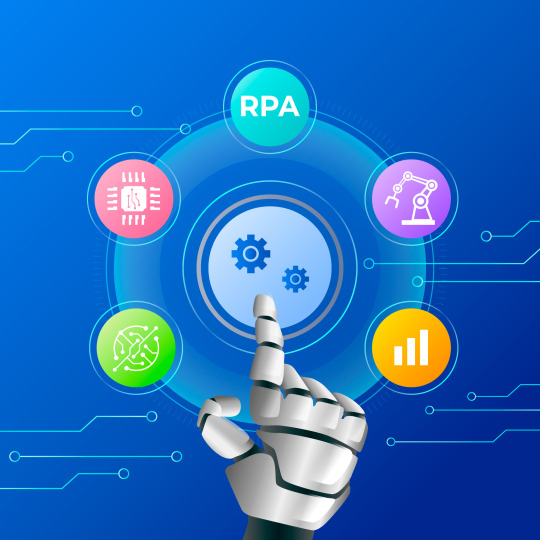
In today's fast-paced and competitive business environment, organizations are constantly seeking ways to improve efficiency, reduce costs, and increase productivity. Robotic Process Automation (RPA) has emerged as a powerful tool that can help businesses achieve these objectives.
What is Robotic Process Automation (RPA)?
Robotic Process Automation (RPA) is a technology that allows businesses to automate repetitive, rule-based tasks. It uses software robots, also known as "bots," to mimic human actions and interact with digital systems. These bots can log into applications, navigate through screens, input data, and complete tasks just like humans would.
The Role of RPA in Business:
RPA can be used to automate a wide range of tasks across various industries and departments. Here are some examples:
Finance and Accounting: Automating tasks such as accounts payable and receivable, invoice processing, and financial reporting.
Customer Service: Automating tasks such as answering FAQs, resolving customer inquiries, and processing orders.
Human Resources: Automating tasks such as onboarding new employees, processing payroll, and managing benefits.
IT: Automating tasks such as provisioning accounts, managing user access, and deploying software updates.
Impact of RPA on Businesses:
Implementing RPA can offer numerous benefits to businesses, including:
Increased efficiency and productivity: RPA can automate time-consuming and tedious tasks, freeing up employees to focus on more strategic and value-added activities.
Reduced costs: RPA can help businesses save money on labor costs, as well as reduce errors and compliance risks.
Improved accuracy and compliance: RPA bots are programmed to follow specific rules and procedures, which can help to improve accuracy and compliance with regulations.
Enhanced process visibility and control: RPA provides businesses with a clear view of their processes, which can help them identify and address bottlenecks.
Improved customer satisfaction: RPA can help businesses improve customer satisfaction by automating tasks such as order processing and customer service interactions.
RPA Services:
Implementing RPA successfully requires a partner with expertise in the technology and a deep understanding of business processes. A comprehensive RPA solution should include the following services:
Document AS-IS Process: This involves mapping out the existing process to identify areas for automation.
Design & Development of Bots, workflows, and forms for process automation: This includes designing and developing the software robots that will automate the tasks.
Bot license (We will use the appropriate underlying technology): This provides access to the software robots and the underlying technology platform.
Infrastructure: This includes setting up the necessary infrastructure to support the Robotic Process Automation (RPA) solution.
Production Deployment of the Bots: This involves deploying the bots to production and monitoring their performance.
RPA support: This includes ongoing support for the RPA solution, such as troubleshooting and maintenance.
Test & Deploy bots to production: This involves testing the bots in a production environment and making any necessary adjustments before they are deployed to full production.
Configuration data changes: This involves making changes to the configuration data of the bots as needed.
Password updates: This involves updating the passwords of the bots as needed.
Errors in executing the Bots: This involves resolving errors that occur during the execution of the bots.
Determining the “root cause” of a recurring issue or incident & recommendations: This involves identifying the root cause of a recurring issue or incident and recommending solutions to prevent it from happening again.
Infrastructure/application related issues: This involves resolving issues with the infrastructure or applications that the bots are interacting with.
Conclusion:
RPA is a powerful technology that can have a significant impact on businesses of all sizes. By automating repetitive tasks, RPA can help businesses improve efficiency, reduce costs, and increase productivity. However, it is important to choose a reputable Robotic Process Automation (RPA) companies with the expertise and experience to help you implement a successful RPA solution.
Ready to embrace the power of RPA?
Contact us today to learn more about how RPA can help your business achieve its goals.
#robotic process automation#robotic process automation rpa#rpa automation#robotic process automation software#rpa software#robotic process automation companies#robotic process automation technology#robotic process automation in healthcare#robotic process automation in banking#rpa solution#robotic process automation for finance#process automation solution#robotic process automation services#robotic process automation for insurance#rpa system#what is rpa automation#robotic process automation solution#robotic process automation benefits#robotic process automation consulting#robotic process automation consultant#rpa service provider#rpa consulting services
2 notes
·
View notes
Text
Exploring the Expansive Horizon of Selenium in Software Testing and Automation
In the dynamic and ever-transforming realm of software testing and automation, Selenium stands as an invincible powerhouse, continually evolving and expanding its horizons. Beyond being a mere tool, Selenium has matured into a comprehensive and multifaceted framework, solidifying its position as the industry's touchstone for web application testing. Its pervasive influence and indispensable role in the landscape of software quality assurance cannot be overstated.
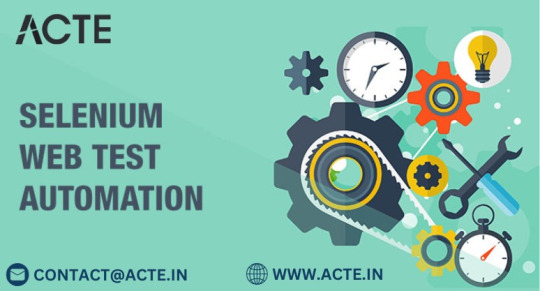
Selenium's journey from a simple automation tool to a complex ecosystem has been nothing short of remarkable. With each new iteration and enhancement, it has consistently adapted to meet the evolving needs of software developers and testers worldwide. Its adaptability and extensibility have enabled it to stay ahead of the curve in a field where change is the only constant. In this blog, we embark on a thorough exploration of Selenium's expansive capabilities, shedding light on its multifaceted nature and its indispensable position within the constantly shifting landscape of software testing and quality assurance.
1. Web Application Testing: Selenium's claim to fame lies in its prowess in automating web testing. As web applications proliferate, the demand for skilled Selenium professionals escalates. Selenium's ability to conduct functional and regression testing makes it the preferred choice for ensuring the quality and reliability of web applications, a domain where excellence is non-negotiable.
2. Cross-Browser Testing: In a world of diverse web browsers, compatibility is paramount. Selenium's cross-browser testing capabilities are instrumental in validating that web applications perform seamlessly across Chrome, Firefox, Safari, Edge, and more. It ensures a consistent and user-friendly experience, regardless of the chosen browser.
3. Mobile Application Testing: Selenium's reach extends to mobile app testing through the integration of Appium, a mobile automation tool. This expansion widens the scope of Selenium to encompass the mobile application domain, enabling testers to automate testing across iOS and Android platforms with the same dexterity.
4. Integration with Continuous Integration (CI) and Continuous Delivery (CD): Selenium seamlessly integrates into CI/CD pipelines, a pivotal component of modern software development. Automated tests are executed automatically upon code changes, providing swift feedback to development teams and safeguarding against the introduction of defects.
5. Data-Driven Testing: Selenium empowers testers with data-driven testing capabilities. Testers can execute the same test with multiple sets of data, facilitating comprehensive assessment of application performance under various scenarios. This approach enhances test coverage and identifies potential issues more effectively.
6. Parallel Testing: The ability to run tests in parallel is a game-changer, particularly in Agile and DevOps environments where rapid feedback is paramount. Selenium's parallel testing capability accelerates the testing process, ensuring that it does not become a bottleneck in the development pipeline.
7. Web Scraping: Selenium's utility extends beyond testing; it can be harnessed for web scraping. This versatility allows users to extract data from websites for diverse purposes, including data analysis, market research, and competitive intelligence.
8. Robotic Process Automation: Selenium transcends testing and enters the realm of Robotic Process Automation (RPA). It can be employed to automate repetitive and rule-based tasks on web applications, streamlining processes, and reducing manual effort.
9. Community and Support: Selenium boasts an active and vibrant community of developers and testers. This community actively contributes to Selenium's growth, ensuring that it remains up-to-date with emerging technologies and industry trends. This collective effort further broadens Selenium's scope.
10. Career Opportunities: With the widespread adoption of Selenium in the software industry, there is a burgeoning demand for Selenium professionals. Mastery of Selenium opens doors to a plethora of career opportunities in software testing, automation, and quality assurance.
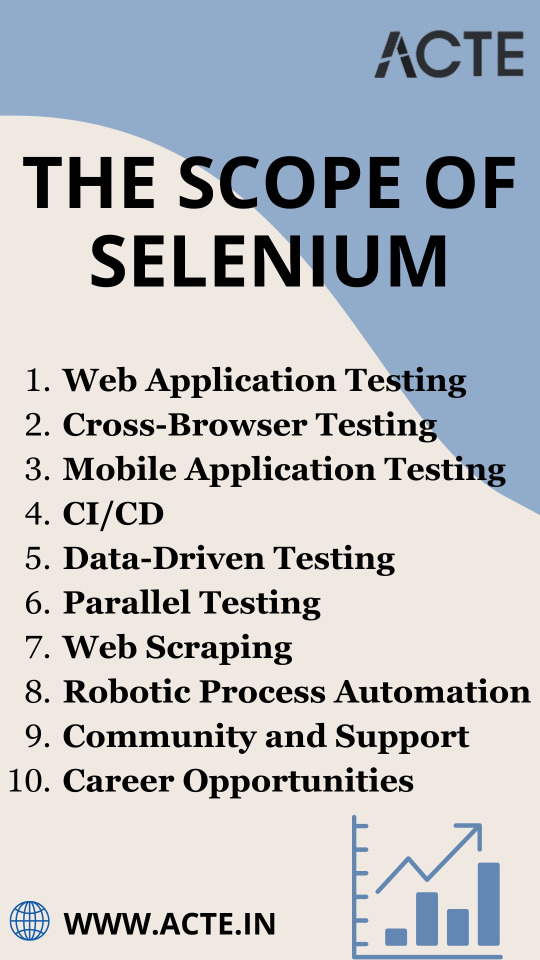
In conclusion, Selenium's scope is expansive and continuously evolving, encompassing web and mobile application testing, CI/CD integration, data-driven testing, web scraping, RPA, and more. To harness the full potential of Selenium and thrive in the dynamic field of software quality assurance, consider enrolling in training and certification programs. ACTE Technologies, a renowned institution, offers comprehensive Selenium training and certification courses. Their seasoned instructors and industry-focused curriculum are designed to equip you with the skills and knowledge needed to excel in Selenium testing and automation. Explore ACTE Technologies to elevate your Selenium skills and stay at the forefront of the software testing and automation domain, where excellence is the ultimate benchmark of success.
3 notes
·
View notes
Text
"What sets TechMindz Infopark Kochi apart from other software training institutes in the area?"
"TechMindz Infopark Kochi stands out from its peers due to its holistic approach to software training. Unlike other institutes, TechMindz Infopark Kochi combines theoretical knowledge with practical application, ensuring that students not only understand concepts but also know how to implement them effectively. With industry-relevant curriculum, hands-on projects, and personalized mentorship, TechMindz Infopark Kochi prepares students for real-world challenges, making it the premier choice for software training in Kochi."
https://www.techmindz.com/courses/
#techmindzkochi#infopark#softwaretraining#python#datascience#digitalmarketing#software testing#ui/ux#corporatetraining#RPA#java#flutter#placement#joborientedcourse#kerala#IT#onlinecourses#onlinetraining#liveclass
0 notes